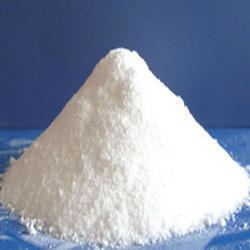Formula CuCN Density 2.92 g/cm³ | Molar mass 89.563 g/mol | |
 | ||
Appearance off-white / pale yellow powder | ||
Copper(I) cyanide is an inorganic compound with the formula CuCN. This off-white solid occurs in two polymorphs; impure samples can be green due to the presence of Cu(II) impurities. The compound is useful as a catalyst, in electroplating copper, and as a reagent in the preparation of nitriles.
Contents
Structure
Copper cyanide is a coordination polymer. It exists in two polymorphs both of which contain -[Cu-CN]- chains made from linear copper(I) centres linked by cyanide bridges. In the high-temperature polymorph, HT-CuCN, which is isostructural with AgCN, the linear chains pack on a hexagonal lattice and adjacent chains are off set by +/- 1/3 c, Figure 1. In the low-temperature polymorph, LT-CuCN, the chains deviate from linearity and pack into rippled layers which pack in an AB fashion with chains in adjacent layers rotated by 49 °, Figure 2.
LT-CuCN can be converted to HT-CuCN by heating to 563 K in an inert atmosphere. In both polymorphs the copper to carbon and copper to nitrogen bond lengths are ~1.85 Å and bridging cyanide groups show head-to-tail disorder.
Preparation
Cuprous cyanide is commercially available and is supplied as the low-temperature polymorph. It can be prepared by the reduction of copper(II) sulfate with sodium bisulfite at 60 °C, followed by the addition of sodium cyanide to precipitate pure LT-CuCN as a pale yellow powder.
2 CuSO4 + NaHSO3 + H2O + 2 NaCN → 2 CuCN + 3 NaHSO4On addition of sodium bisulfite the copper sulfate solution turns from blue to green, at which point the sodium cyanide is added. The reaction is performed under mildly acidic conditions. Copper cyanide has historically been prepared by treating copper(II) sulfate with sodium cyanide, in this redox reaction, copper(I) cyanide forms together with cyanogen:
2 CuSO4 + 4 NaCN → 2 CuCN + (CN)2 + 2 Na2SO4Because this synthetic route produces cyanogen, uses two equivalents of sodium cyanide per equivalent of CuCN made and the resulting copper cyanide is impure it is not the industrial production method. The similarity of this reaction to that between copper sulfate and sodium iodide to form copper(I) iodide is one example of cyanide ions acting as a pseudo halide. It also explains why copper(II) cyanide, Cu(CN)2, has not been synthesised.
Reactions
Copper cyanide is insoluble in water but rapidly dissolves in solutions containing CN− to form [Cu(CN)3]2− and [Cu(CN)4]3−, which exhibit trigonal planar and tetrahedral coordination geometry, respectively. These complexes contrast with those of silver and gold cyanides, which form [M(CN)2]− ions in solution. The coordination polymer KCu(CN)2 contains [Cu(CN)2]− units, which link together forming helical anionic chains.
Copper cyanide is also soluble in concentrated aqueous ammonia, pyridine and N-methylpyrrolidone.
Applications
Cuprous cyanide is used for electroplating copper.
Organic synthesis
CuCN is a prominent reagent in organocopper chemistry. It reacts with organolithium reagents to form "mixed cuprates" with the formulas Li[RCuCN] and Li2[R2CuCN]. The use of CuCN revolutionized the deployment of simpler organocopper reagents of the type CuR and LiCuR2, the so-called Gilman reagents. In the presence of cyanide, these mixed cuprates are more readily purified and more stable.
The mixed cuprates Li[RCuCN] and Li2[R2CuCN] function as sources of the carbanions R−, but with diminished reactivity compared to the parent organolithium reagent. Thus they are useful for conjugate additions and some displacement reactions. Addition of CuCN to
CuCN also forms silyl and stannyl reagents, which are used as sources of R3Si− and R3Sn−.
CuCN is used in the conversion of aryl halides to nitriles.
